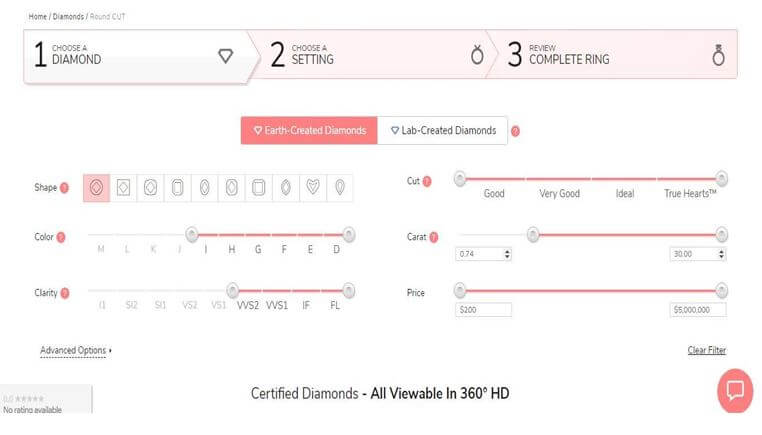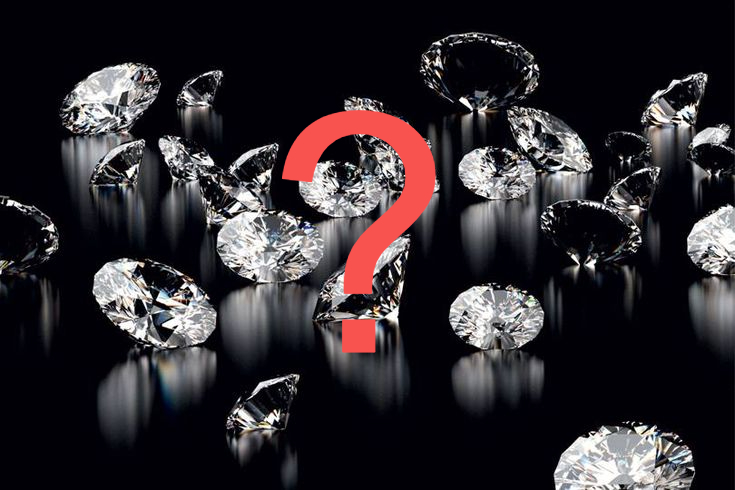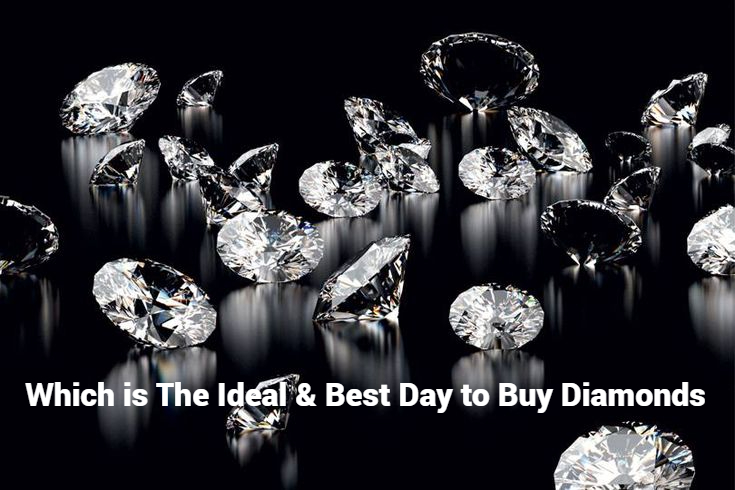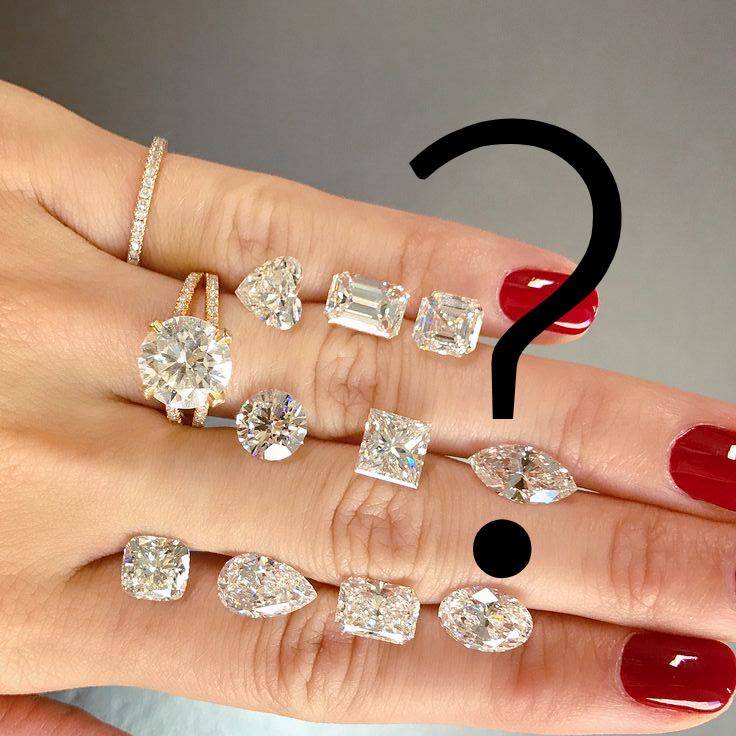INTRODUCTION
- HOW TO SELECT YOUR DIAMOND (STEP BY STEP)
- Understand the 4Cs
- Cut: Interaction of diamond with light. It determines brightness, scintillation, and fire
- Clarity: Refers to the absence of inclusions or flaws in the diamond. It is a very flexible characteristic
- Color: Grades the absence of color. The more colorless, the higher the value.
- Carat: The most popular feature. The bigger, the more expensive, generally speaking.
- Select your preferred jeweler
- Online stores are better than offline retail stores. They offer a wider range of options and better deals
- The top four online stores are:
- James Allen: offers 30 days money-back guarantee and large collection
- Whiteflash: Large diamond collection and exceptional customer service
- Brian Gavin: Known for super ideal cuts and has a personal inventory
- Blue Nile: the Largest online collection of diamonds and the oldest in the business. Also site for the cheapest quality diamonds.
- These stores have areas where they are focused on and you can explore those areas to your advantage.
- Select your diamond
- Select the shape: A round cut or princess, if none is specified by the recipient
- Select the carat: This is usually of sentimental value to the recipient, so get it right as much as you can.
- Begin to adjust other features until you get a diamond that fits well into your budget. The adjustments should be in the following order:
- Clarity
- Color
- Cut
- Going below Good for cut, or S1 for clarity and J or color is not advised, instead, consider increasing your budget
- Other tips include:
- Shape: If you have a specific message to passage cross, a heart shape could help, otherwise, pick a round or princess shape.
- Carat: a decrease of 10% would not be obvious when viewed. You can exploit this to your advantage.
- A marquise cut would be better if you are going below 0.80ct
- Color:
- In color grades higher than I, color changes are difficult to detect, so you can go lower.
- Consider the setting the diamond would be placed. If it would hide the color, you can go lower, if the reverse is the case then go higher.
- The larger the diamond, the more easily color is detected.
- Cut: Determines the overall appearance of the diamond. It should not be toyed with!
- A color grade of Excellent or Very good is ideal
- A Good grade is the least to go for round cuts and Fair for fancy shapes
- Poor cut grade should be avoided at all costs.
- The culet should be none to prevent light leakage
- The girdle should be very thin or thin to slightly thick
- Get a diamond report from reputable labs like GIA
- A diamond report provides verifiable proof of your diamond’s cut grade
- It helps you know if the diamond has been altered in any form
- Helps to distinguish natural from laboratory grown diamonds
- Inscription of security Identification numbers in case of theft
- Important for resale in the future
- Appraise and Insure your diamond
- The appraisal helps in evaluation of a diamond’s price
- Insurance is important; the diamond is a valuable investment.
- Understand the 4Cs
The question for today is: How do I buy a diamond?
This question, as easy as it looks is a billion-dollar question. If some folks asked this question before going ahead to make a purchase, they would have probably been spared the hurt of purchasing a diamond that was far below their expectations.
To answer this question, we would go step by step.
Related: What are the Best Places to Buy Diamonds
HOW TO SELECT YOUR DIAMOND
The first thing you need to do is to definitely select your diamond.
1. UNDERSTAND THE 4CS:
There is no debating this. Get articles that would give you more understanding of Diamond 4cs. The understanding of these characteristics helps you know what to expect when buying your diamond
- Diamond cut: The diamond cut is the interaction of the diamond with light. It would determine the brightness, scintillation, and sparkle of the diamond you want to buy. It is the most important quality of the diamond that should not be sacrificed for anything.
- Diamond Clarity refers to the absence of inclusions or flaws in the diamond. It is more flexible than the cut and can be adjusted over a wider range.
- Diamond color: Diamond color grades the absence of color. The colorless diamonds are ranked higher than those with color. It is important to understand that color would affect the value and price of your diamond.
- Diamond carat: Refers to the weight of the diamond. Most people know about this and generally the higher the carat of a diamond, the higher the value and price of the diamond.
Another thing that knowing the diamond Cs would do is to help you know which feature of the diamond you can adjust or be more flexible with, in case your desired diamond is outside your budget range.
2. SELECT YOUR PREFERRED JEWELER :
Now that you understand the 4Cs, it is time to get a jeweler that would help you get the best diamond you have been craving. The truth is that there are several diamond dealers out there, that you might want to get so confused about which to pick. However, there are those that we recommend and over time have proven themselves.
I should tell you that they are all online stores because as you must have noticed, the online market has grown beyond any other offline retail chain. Online stores give you a better range of options to choose from, all done in the comfort of your room.
If you are bothered about inspection, do not worry, these diamond sellers we recommend to you have High definition pictures and videos of every diamond they sell, viewed from different angles and under different lighting conditions. Our recommended stores are:
- James Allen:
- Offers 30 days money-back guarantee
- Consistent over time
- Huge collection of diamonds
- Allow thorough inspection if diamonds before they are bought
- Whiteflash:
- Known for their best sales policies
- Have exceptional customer service
- Have a large collection of diamonds with excellent cuts.
- They also have very strict quality control
- Blue Nile:
- Has been around for a long time. They are actually the oldest retailers online
- Largest online collection
- You can get at the cheapest prices online without quality reduction
- They are also the best retailers for international customers outside the US
- Brian Gavin:
- Known for having super ideal cuts
- Runs a personal inventory, meaning all products are personally identified and examined (others might just get them straight from the manufacturer and put them online)
- Provides well-detailed analysis for every stone displayed
One thing that is common to all these sites is that they all help you to understand the 4cs and how the 4Cs affect your diamond. They also provide a very good visual assessment of the diamond, in addition to other assessments that are made available by some of them.
Some people have advised that you select your jeweler as carefully as you select your doctor, or maybe a barber or hairstylist. Make sure that you go through their online stores.
Selecting any jeweler should be based on what you need and other factors, like where you stay and your budget.
You know, you could actually just go through all their sites and make a decision on which jeweler you want to go with.
3. SELECTING THE DIAMOND:

Next, we move to the diamond selection process proper. One advantage of online stores is that they provide various sliders that allow you to adjust the specifications of each feature of the diamond so that you have a wide range of options within the specifications you selected.
- Select the shape the recipient would prefer. If the recipient does not know or have any, you can select the round cut or the Princess cut. The reason for these two is that they are the ones with the most brilliance.
- Select the Carat: Most people usually have an idea of the carat weight that they would want. Ensure you do this first. Carat has sentimental value. It is not the most important, but if someone wants a 1.5 ct and you get them a 1 ct, no matter how much you try to explain the Cs of the diamond, they might feel totally unsatisfied!
- Begin with the highest quality of all the specifications like cut, clarity, and color with the carat and shape that you have chosen. Begin to adjust the slide in the following order until you get options that suit your budget:
- Reduce the Clarity: Begin with the clarity, you can go as low as VS2 before you consider reducing other features.
- Reduce the Color: You can reduce the color grade to H, before reducing other features.
- Reduce the Cut: You should not go below a Very good cut for Round cuts and Good cut for fancy shapes.
Now, if after doing this, you still have not arrived at a diamond that your budget can accommodate, you might have to repeat the whole process again, following the same order:
- Clarity: You can take it a bit lower; as low as SI1
- Color: Reduce this next. You can get to K
- iii. The cut grade can go lower to good in round cuts and fair in fancy shapes.
The only thing to note is that as you make concessions, the quality of the diamond would also reduce. However, you can still get the best of your budget range following the order that I am giving.
If you are still outside your budget range, you would have to make some concessions based on your preferences. You might also consider reducing the carat and then tweak the color (which would become obvious) and then the cut a little more (which is not advised).
You might also want to consider increasing your budget at this point.
The process of selecting a diamond can be very interesting when done online. You get to choose from a huge collection and adjust the different features of your diamond.
This is one of the many reasons why we believe that buying online is way better. You cannot easily do all those adjustments offline the way you would do them with just a slider online!
TIPS TO HELP YOU SAVE MORE WHEN SELECTING YOUR DIAMOND
SHAPE:
Ensure you always get the input of the recipient of your diamond on the shape. If they are not sure or are not supposed to be aware, let the occasion decide for you. If you are trying to pass a very strong message, a heart shape could do. However, in the absence of specific occasions like this, you can always trust a round cut. A round cut has more fire, scintillation, and brilliance than any other cut. Take note of the Length to Width ratio, in case you are looking for a wider or narrower diamond.
CARAT:
The Carat is the characteristic most people are familiar with; therefore, you should be careful how you adjust this. However, a 10% decrease or less in carat would not be obvious to the eye. You should know this in case your desired diamond is not within your budget range and you are looking for things to reduce. Again, make sure you inspect the diamond fully so that you can know how it would look by the time you purchase it. This is more important when purchasing diamonds for engagements or weddings. More attention is paid to every detail and specification given.
If there are no strict specifications, and a diamond below 0.80ct would be purchased, you can get a Marquise cut, which has the advantage of appearing bigger than other diamond shapes of an equal carat.
COLOR:
There are a number of things to note as regards color when buying diamonds:
- In color grades higher than I, color changes are very difficult to detect. In fact, most observers would not be able to tell the difference when they are placed side by side. Therefore, you can choose to go for lower color grades above I and increase other features.
- Look out for the setting the diamond would be used in. An H diamond set in normal lighting can look as colorless as a D or E grade of color. Therefore, utilize this information to save some more money on color. If the setting would be one that is colored, selecting a colorless grade diamond would not make much difference. If the background would be a white or similar color, then you might have to go for the higher color grades.
- The larger the diamond, the more easily color is detected. Therefore, for diamonds that are more than 1 Ct, you should get a G –H color grade. If they are lesser than 1 ct, an I – J color grade would do. Some cuts like round cuts and princess cuts have a number of facets, therefore, they are able to hide coloring better. This is another reason why brilliant cuts are preferred to step cuts, which would show more color, especially around the edges.
CLARITY:
In buying diamonds, clarity is one of the most flexible factors. Clarity measures the absence of inclusions. But the thing about inclusions is that they are not usually visible with the naked eye until you get to a very low grade. This means you can go as low as possible to get a diamond of your choice. A flawless diamond would have no inclusion at 10x magnification. For the very very Slightly Included, the flaws would not be visible to the naked eye, same with the Very Slightly Included. This means that you can buy an eye-clean diamond, up to the VS level. You can see why it is regarded as being flexible. It should usually be the first feature you want to reduce in case you are trying to fit into your budget.
Besides, depending on the setting, some diamonds can be placed in such a way that the setting masks the inclusions that they have. In such a setting, then diamond clarity would not have a really important role in determining which diamond you should go for. If the setting, however, is one that would make a flaw more obvious, you would have to be careful in how low you go while selecting your diamond.
CUT:
In buying your diamond, the cut is the most important feature to consider. The cut determines the brilliance, the fire, and the scintillation of your diamond. You don’t wanna go around toying with this!
There are some things to note here. Several diamond sellers have decided to assign their own cut grades to their diamonds, even when the diamond, in reality, does not merit such a grade.
Therefore, only GIA grades should be used in assessing a diamond. If you are buying any diamond, if the grade is not the GIA grade, then it is better you leave the diamond. Anyone can label a diamond ‘excellent’ or ‘super ideal’ and as such, justify inflation in the price of the diamond. As a buyer, you have to make sure that the diamond is worth the grade you are paying for.
A diamond cut grade of Excellent or Very good is ideal. When you select this, pay attention to the symmetry and the polish. Make sure they are also excellent or very good so that the brilliance of the diamond is not obscured. (Although, ideally, the cut grade would have taken all these into consideration)
Good or fair diamonds should only be concessions based on the budget size so that there can be an increase in carat. They would perform better for fancy shapes. For round brilliant, they would be significantly deficient in brilliance and scintillation that is observed in higher grades.
As much as possible, try to avoid the poor cut grade. This would look dull and lifeless and would defeat the entire purpose of the diamond.
You can consider raising your budget instead of going for a poor cut.
Other things to be considered include:
Culet: Should be None for optimal brightness and to prevent leakage of light
Girdle: Girdles should not be extremely thin so that they do not get broken easily. Girdles from very thin or thin to slightly thick would do for most diamonds. This range would be thin enough to allow light and not cause any reflections in the pavilion, while it would not be too thin as to get broken or chipped off around the edges.
If there is any reason to pick a very thin girdle, try to ensure that the diamond is set in a way that protects the edges and corners.
Polish and symmetry should not be a major consideration in diamonds with very good and excellent cut grades. It only becomes more important as you go lower in the grades. It can also be important when trying to decide between two diamonds of the same very good or excellent grade.
4. DIAMOND REPORT
Now that you have your diamond, make sure that you get your diamond grading report, certified by reputable diamond grading laboratories like the GIA. A report would:
- Provide Verifiable proof of the diamond’s cut grade: GIA reports would have put all the components of cut, clarity, color, and carat together to come to an appropriate grade for the diamond. This grading is unbiased, objective and can certainly be trusted.
- It helps you to know if a diamond has been altered in any form: Some diamonds might be altered by treatment to either correct some flaw or add some features. A grading report would, therefore, help you to know if truly the diamond is as authentic as the sellers claim.
- Helps to separate natural from lab grown diamonds: It is impossible to physically distinguish a lab-grown diamond from a natural diamond and it would be unfair to a buyer to be unaware of what they are buying. Diamond grading reports would specify if the diamond is natural or synthetic.
- The GIA also issues a secure identifying number which can always be used to recognize your diamond in case of theft or any unforeseen circumstances. Their inscription services can also extend to requested messages, logos or numbers as desired…a love message maybe?
- The report once gotten can also be useful for you in case you want to sell the diamond. It would not be difficult to convince potential diamonds since you have a report.
These and many more reasons are why you should insist on getting a diamond report from a reputable lab like GIA whenever you purchase a diamond.
In getting reports, ensure that the lab you get it from has been consistent over the years. We recommend GIA any day and at any time.
5. APPRAISEANDINSURE YOUR DIAMOND
DIAMOND APPRAISAL refers to the evaluation of a diamond based on the key properties like carat, cut, color weight with a view to coming to an objective determination of the value of that diamond. A diamond appraisal is one of the requirements that your insurance company would demand from you.
The diamond appraisal can be done by some manufacturers or independent appraisers.
Some jewelers would include the diamond appraisal document when the diamond is purchased, along with the GIA certificate and other important documents.
This can serve, but if you want to look for an independent appraiser, then you should look out for the following things:
- Ensure the appraiser is truly independent. No affiliations with any vendors or laboratories that can influence their decisions.
- Make sure that the appraiser is a graduate gemologist from GIA
- The appraiser should conform to the Uniform Standard of Professional Appraisal Practice (USPAP)
- The appraiser should be experienced in appraising different types of diamonds over the years
- Appraisal associations exist and the appraiser should be one for the sake of accountability
- For your good, they should have a flat fee, not a percentage which some appraisers are fond of using
- The examination and appraiser of your diamond should be done in an open environment while you are present at all times throughout the procedure.
DIAMOND INSURANCE
Do not be surprised about this. Your diamond is a jewel of value. It should be insured. Discuss with your insurance company and pick a suitable policy for you, in case of theft. Most policies do not cover damage to the diamond.
Once you have followed all the steps in this article, you can be sure that you would have no issues in the process of procuring your diamond. We have exhaustively told you about things to look out for, things to avoid and things to insist on.
You can always speak to your gemologist if you are not clear on any subject.
The most important thing in the diamond purchase is getting what you want.
In the end, your preference would overrule whatever guides we have given, therefore …
As the movies say, ‘follow your heart…’


